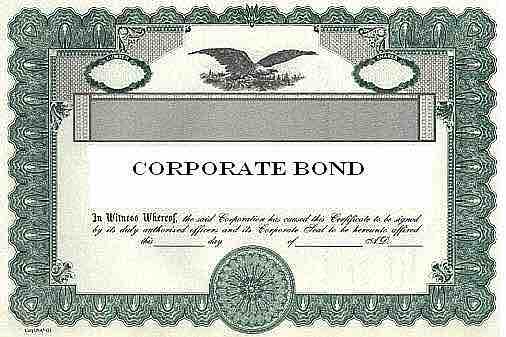Corporate Bonds
A corporate bond is issued by a corporation seeking to raise money in order to expand the business. The term corporate bond is usually applied to longer-term debt instruments with a maturity date falling at least a year after the issue date. (The term commercial paper is sometimes used for instruments with a shorter maturity period. ) Sometimes, corporate bond is used in reference to all bonds with the exception of those issued by governments in their own currencies. Strictly speaking, however, the term only applies to bonds issued by corporations .

Corporate Bond
A corporate bond is issued by a corporation seeking to raise money in order to expand its business.
Corporate bonds are often listed on major exchanges (and known as listed bonds) and ECNs, and the coupon (i.e., the interest payment) is usually taxable. Sometimes, the coupon can be zero with a high redemption value. However, though many are listed on exchanges, the vast majority of corporate bonds in developed markets are traded in decentralized, dealer-based, over-the-counter markets.
Corporate bonds and corporate debt fall into several broad categories:
Secured loan/debt:
A secured loan is one in which the borrower pledges some asset (e.g., a car or property) as collateral for the loan, which in turn becomes a secured debt owed to the creditor of the loan. The debt is thus secured against the collateral, and in the event that the borrower defaults, the creditor takes possession of the collateral asset and may sell it in order to recover some or all of the amount loaned.
Unsecured loan/debt:
The opposite of secured debt is unsecured debt, which is not linked to any specific piece of property. In the case of unsecured debt, the absence of collateral means that the creditor may only satisfy the debt against the borrower. The comparative security of secured debt for the lender generally results in lower interest rates for secured than for unsecured debt. However, the borrower's credit history and ability to repay, as well as the expected returns for the lender, are factors that also affect rates.
Senior debt:
Senior debt, frequently issued in the form of senior notes and sometimes referred to as senior loans, is debt that takes priority over unsecured or junior debt owed by the issuer. Senior debt has seniority over subordinated debt in the issuer's capital structure. In the event of bankruptcy or liquidation, senior debt must be repaid before any other creditors receive payment. Senior debt is often secured by collateral on which the lender has placed a first lien, which typically covers all the assets of a corporation and is frequently used in the resolution of credit lines.
Subordinated debt:
Subordinated debt is repaid after other debts in the case of liquidation or bankruptcy. Such debt is referred to as subordinate, because the debt providers (the lenders) have subordinate status relative to the normal debt. Subordinated debt has a lower priority than the issuer's other bonds and ranks below the liquidator, government tax authorities, and senior debt holders in the hierarchy of creditors. Because subordinated debt is repaid only after other debts have been paid, they are riskier for lenders. Subordinated debt is also unsecured and has a lower priority than any additional debt claim on the same asset.
In the event of a default, the higher one's position in the company's capital structure, the stronger one's claims to the company's assets.